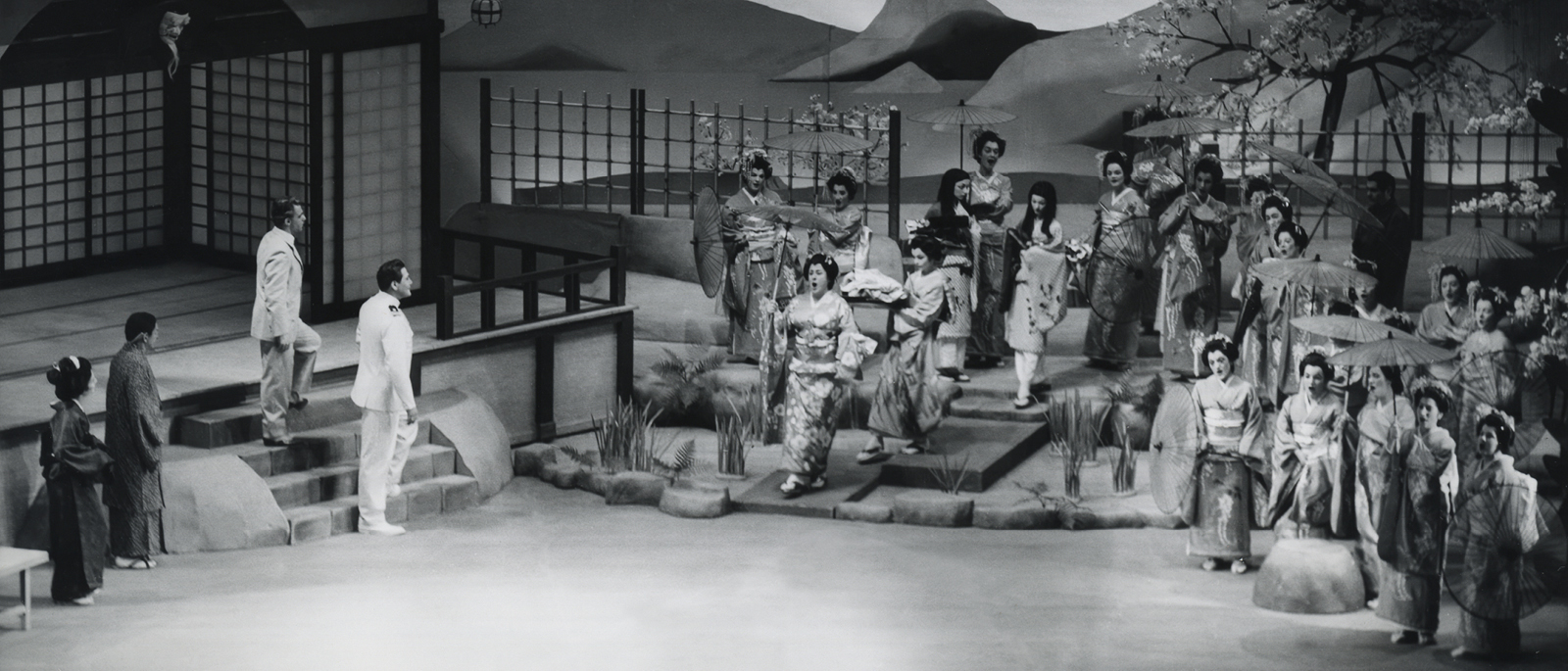
Madama Butterfly
Puccini attended rehearsals and the Met premiere of Madama Butterfly in 1907. The composer spent five weeks in New York, followed everywhere by the press as a major celebrity. His official remarks were polite, but privately he wrote that “rehearsals were too hurried” and that the Met premiere of Madama Butterfly was “excellent, but lacked the poetry I put into it.” By this time, Puccini’s soaring popularity with audiences carried along previously doubting critics, and Butterfly was a resounding success with both groups. The opera was given every season from 1907 to 1937 and is the seventh most performed work in Met history with 902 staged performances prior to the 2023–24 season.
In spite of his fondness for beautiful women, Puccini found the famously attractive soprano Geraldine Farrar “not what she ought to have been” and thought that “she sings out of tune, and her voice doesn’t carry too well.” Despite the composer’s reservations, Farrar had a huge success as Cio-Cio-San, going on to sing the role 139 times with the company, more than any soprano in Met history.
Photo: Sembach
Joseph Urban’s set design for Act II of the 1922 production of Madama Butterfly.
Photo: White Studio
Left: The Met agreed to pay Puccini 20,000 lire, plus travel expenses, in exchange for the composer to oversee the productions and attend the premieres of Manon Lescaut and Madama Butterfly.
Right: Giacomo Puccini sat for his portrait by the noted photographer Aimé Dupont during his 1907 visit to New York.
Left: Italian soprano Licia Albanese made her Met debut as Cio-Cio-San in 1940 and was a favorite in the role for the next year — until the opera was dropped from the repertory following the attack on Pearl Harbor in December 1941. Albanese again took up the role when Madama Butterfly returned to the Met repertory in early 1946 and continued as a familiar interpreter
of the part for two more decades.
Right: Cio-Cio-San’s Act I entrance in the 1946 revival of Madama Butterfly, starring soprano Licia Albanese in the title role. The 1922 production was still in use.
Photo: Sedge LeBlang
In 1958, the Met staged a new production of Madama Butterfly intended to be authentically Japanese. Yoshio Aoyama directed the staging, which featured designs by Motohiro Nagasaka. Aoyama’s work with the singers, particularly soprano Antonietta Stella in the title role, received wide acclaim. Considered one of the company’s finest stagings, the production played 335 times before being replaced in 1994.
Photo: Louis Mélançon
Left: Following the historic 1955 debut of contralto Marian Anderson — the first African American to sing a leading role at the Met — many young Black artists began to join the company’s roster. Soprano Martina Arroyo made her Met debut in 1959, and in 1965, she sang the title role of Madama Butterfly.
Photo: Louis Mélançon
Right: Madama Butterfly has served as a company-debut role for numerous Asian sopranos, including Atsuko Azuma and Yoko Watanabe.
Watanabe Photo: James Heffernan;
Left: Atsuko Azuma
Photo: Louis Mélançon
Right: Soprano Teresa Stratas portrayed the title role of Madama Butterfly in the 1968 revival of the Aoyama production. She is seen here in Act II, with mezzo-soprano Nedda Casei as Suzuki.
Photo: Frank Lerner
Left: The role of Lieutenant B. F. Pinkerton was one of the first roles assigned to George Shirley, the first Black tenor to sing leading parts at the Met. In all, Shirley sang 251 performances and 28 roles with the company from 1961 to 1973.
Photo: Louis Mélançon
Right: For more than two decades, Renata Scotto was a much-admired interpreter of the title role of Madama Butterfly, which served as her Met debut in 1965. Because of Scotto’s diminutive size and impassioned portrayal, Cio-Cio-San became the Italian soprano’s signature role.
Photo: Frank Lerner
Left: A new production by Giancarlo Del Monaco took the Met stage in 1994. His staging of the Act I love duet, which had tenor Richard Leech’s Pinkerton roughly handling soprano Catherine Malfitano’s Cio-Cio-San, drew some protest from the audience (most notably from soprano Licia Albanese, the retired diva and a famous Butterfly herself).
Photo: Winnie Klotz
Right: The Del Monaco production was revived in 1997, with American soprano Michèle Crider making her company debut in the title role.
Photo: Erika Davidson
Act I of the 1994 production of Madama Butterfly, directed by Giancarlo Del Monaco and designed by Michael Scott.
Photo: Marty Sohl, 2003–04
The first new production under General Manager Peter Gelb was Madama Butterfly, staged by famed film director Anthony Minghella in 2006 and featuring costumes by Han Feng. It includes a huge mirror above the stage that is used to striking effect throughout the opera, including in Butterfly’s Act I entrance.
Photo: Ken Howard
Left: Chinese soprano Liping Zhang sang the title role of Madama Butterfly for her Met debut in 2004 and again in the 2011 revival of Anthony Minghella’s production.
Photo: Marty Sohl
Right: Chilean soprano Cristina Gallardo-Domâs, who sang Cio-Cio-San in the premiere of Anthony Minghella’s production, is shown here with the puppeteers who operated the Bunraku-style puppet that represents her child.
Photo: Ken Howard
Madama Butterfly